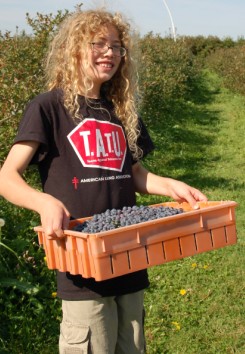Techniques for Harvesting Crops by Hand
When farmers allow volunteers into their fields and orchards to harvest vegetables or fruits, they naturally want to avoid damage to crops providing their livelihood. Meeting with the farmer ahead of a gleaning event is vital when the farmer won’t be present. Following the grower’s instructions and marking rows or trees with plastic ribbons or flags avoids misunderstandings. Always check with the farmer or gardener to determine if crops are to be picked selectively or harvested completely. Also, ask if there’s a preferred harvesting technique. If not, here are some harvesting tips: 
Apples: Fruit is ripe when stems snap as you bend apples away from branches, removing them without disturbing the nearby buds for next year’s crop. Pick apples with the stem intact.
Beets: Baby beets can be harvested and the remainder left to mature. Beets are edible at any diameter. Young beet tops also can be cooked for a green vegetable.
Brussel Sprouts: Pick from the bottom of stem as sprouts mature from the bottom up.
Blueberries: Strip berries into a container worn on your body and empty into a flat in the row. When full, move the flat to the end of the row for pickup and weighing.
Carrots: The diameter of a carrot poking through the soil indicates its length and maturity. Thinning carrots provides bunches of baby carrots and allows other carrots in the row to mature. Use a straight tine fork for lifting carrots from clay soil. If that’s not available use a traditional fork with curved tines but dig down farther from the row.
Chard: For selective harvest, circle one hand over a core five or six leaves and with the other hand press down on outer leaves to server from plant. See directions here.
Cabbage: Firm centers indicate which cabbages are ripe for harvest. Do not cut cabbage open. Give whole to food banks regardless of the size for sanitary reasons. Knives are the most convenient for harvesting cabbage. Cut cabbage above ground from the root.
Corn: Dry, brown silks indicate ripeness. Snap ears back away from plant and insert into canvas harvesting bag worn across your body if available.
Green beans: Pick the largest ones and leave small ones to grow longer. Length typically indicates readiness for harvest, but pick before you see beans bulging and when stems snap easily.
Kale: For selective harvest, leaves can be picked throughout the growing season. For complete harvest, bend leaves and strip with downward sweeps. See directions here.
Leeks: Dig leeks, Cut off roots. Trim greenery to about 4 to 6 inches. Peel back the outer white layer of leek to remove excess soil from stem. Remove roots. See directoins here.
Lettuce: Firm heads are ready for removal from stem with a serrated knife. Outer leaves of leaf lettuce may be plucked to allow inner leaves to grow for a continuous harvest throughout the growing season.
Potatoes: Dig potatoes with a straight tine fork. Store in a cool, dark place. Do not leave in light. The parts of potatoes exposed to light will turn green, which indicates a toxic substance called solanine may have formed and the potatoes aren’t suitable for eating.


